The Statistical Accounts of Banffshire
**********
PARISH OF GAMRIE.
PRESBYTERY OF TURRIFF, SYNOD OF ABERDEEN.
THE REV. THOMAS WILSON, MINISTER.
(Drawn up by Mr Alexander Whyte, Parochial Schoolmaster of Gamrie)
I.—TOPOGRAPHY AND NATURAL HISTORY.
Name.—The parish of Gamrie, or, as it has been named at different times, Gamery, Ghaemrie, or Gemrie, according to generally received tradition, derives its name from a Gaelic word, Kemrie,—signifying a running leap or running fight,—on account of a bloody engagement with the Danes on the spot where the old church now stands.
Extent and Boundaries.— The parish is about 10 miles long from east to west, and from 3 to 4 broad. It is bounded on the north by the Moray Frith; on the east, by the brook or burn of Nethermill, which separates it from Aberdour; on the south, by King-Edward; and on the west, by King-Edward, Alvah, and the river Doveran, which separates it from Banff.
Topographical Appearances.—The surface of the parish is exceedingly diversified by hills, glens, and precipices. This appears to be occasioned by the singular nature of the sea-coast, which is skirted by a narrow ledge of stupendous rocks, running the whole length of the parish, and of the eastern adjoining one of Aberdour, in some places perpendicular towards the sea to the height of 600 feet, and in all precipitous. The bay of Gamrie is formed by the jutting out into the sea of two headlands, Gamrie-head and Troup-head, leaving between them a large open bay, with fine anchorage ground for vessels of any size. The view of the coast from sea, outside the bay, is much admired. At the bottom of the bay, the rocks, which are steep and rugged on either side, retire a little, leaving room for the village of Gardenstown, and no more; and then they rise with just as much bend from the perpendicular as allows mould to lie upon them, which is closely covered with green grass, except here and there a winding footpath like a staircase, on which few can venture without fear and trembling, except the natives. From the tops of these braes, as they are called, one could almost fancy he might peep down the chimneys of the houses; and so abrupt is the rising of the ground in some places, that one house of three stories has them all ground floors, one entrance being at the front, another at the back, and the third at an end. On the east side of the bay, the little fishing village of Crovie lies about a mile from Gardenstown, with the one gable-end of the houses to the sea, and the other to the land, and this last is bored, as it were, into the bank, like a brood of young sea-fowl, nestling with their heads under the dams; and nearly at the same distance on the west side, stands the old church and church-yard, on a ledge of the hill's brow ; which one would think in equal danger of being smothered by the hill hanging over it, and of being undermined by the sea below.
From the bay of Gamrie alone of all the coast, except at the western extremity, before the high rocks commence, the land rises gradually, that is, from the top of the braes, with more or less acclivity, for upwards of a mile into the interior. The most singular appearance of all the other coast is, that it is not the termination of higher lands from the interior, but that it slopes down from the sea towards the south, sometimes immediately, but generally after a few furlongs of plain on the top, and forms glens parallel with the shore, which are scarcely less admired than the shore itself, for their rich verdure and picturesque scenery. The rocks themselves, or narrow hills between these glens and the sea, are generally covered at their tops with heath; and to a person standing on their highest eminences, and surveying the wide extending plains, woods, and mountain-tops southward and westward, and the threatening ocean north, the reflection can hardly fail of offering itself, that these strong barriers of the mighty deep have been placed before its proud waves by the hand of Omnipotence, as a memento of his resistless fiat, "Hitherto shalt thou come, and no further."
Another circumstance that diversifies much the appearance of the parish is, that the rocks on the coast are not carried wholly in a continuous chain from end to end, but are broken in upon with chasms or cross dens to their very bottoms, appearing as if the rocks had been rent asunder by some great convulsion. In the zigzag projections of the opposite sides of these cross dens, each protuberance of the one corresponds with a like opening of the other. From this last appearance some think that these gulleys have been formed gradually during the lapse of ages, by the action of water washing away the soft earth, and leaving the hard rock standing, first abrupt, and afterwards sloped by the mouldering away of the sharp edges; but the general belief is, that the glens were formed at once by the flood, when the windows of heaven were opened, and the fountains of the great deep were broken up. There are four of these dens, or great openings in the rocks, which serve as outlets for the water of the interior, and which, branching off, or widening as they retire from the sea, become straths or valleys. The first to the westward is called Oldhaven, between the lands of Cullen and Melrose; the second, and principal one, east of the old church, called the Den of Afforsk; the third, at the fishing village of Crovie; and the fourth at Cullycan, near Trouphouse. Nothing can be more lovely and romantic than the scenery of these passes or ravines, in their approach to the sea. A short description of the one below the old church may be interesting, as it is the deepest of the whole, and the richest in natural scenery. The best view of the den is from a ledge or table of rock about half way down the point of the Rin of Afforsk, a steep acclivity in the form of a wedge which separates the ravine into two, and where the two burns meet at the bottom. There is thence a view of the higher part above the church, covered with heath, furze, and occasional bushes of rasp and whortleberries (blaeberries) in the more sheltered spots; and below, of the beautiful deep-winding valley or ravine, with the clear brook at the bottom, gurgling through its numerous sinuosities, overhung sometimes with the naked rock standing in single gray buttresses, like fragments of an old castle,—and then sparkling up to the steep banks which rise high on either side, exhibiting all the shades of green according to their position, with here and there a brake of thorns, well-peopled with thrushes, blackbirds, linnets, and other songsters, which enliven the solitude with their music. The point of the Rin below, and all the western valley above it, as well as that on the east side, is loaded with a profusion of herbage, and affords the best field for botany in the parish. Even one who is no botanist cannot help admiring the richness and variety of herbage and gaudy wild flowers in this locality. The rocky places are throughout ornamented at the bottom with wild geraniums, cranesbills, foxglove, primroses, hawthorn, wild-roses of different colours, and other indigenous flowers of the season; while the modest wild strawberry may be seen blushing in the crevices, and the green ivy insinuating itself into every chink, and climbing up the shelving sides.
Caves.— As might be supposed, amongst such gigantic masses of rock, here are several caves along this coast; and among others of inferior note, two in the neighbourhood of Troup deserve particular notice. The first is about 50 fathoms deep, 60 long, and 40 broad, from which there is a subterraneous passage to the sea, about 80 yards long, through which the waves are driven with great violence in a northern storm, and occasion a smoke to ascend from the den. Hence it has got the name of Hell's lum. The other is a subterranean passage through a peninsula of about 150 yards long from sea to sea, through which a man can with difficulty creep. At the north end of this narrow passage, is a cave about 20 feet high, 30 broad, and 150 long, containing not less than 90,000 cubic feet. The whole is supported by immense columns of rocks, exceedingly grand, and has a wonderfully fine effect, after a person has crept through the narrow passage. This place is called the Needle's Eye.
Meteorology.—The climate may be considered comparatively dry and healthy. The temperature varies greatly in different parts of the parish, the high lands being cold and the valleys warm. It in general may be considered colder than the interior, owing partly to the elevation of the land, and partly to the prevalence of north winds and storms from the German Ocean. Less snow lies, however, than in the interior, owing to the exposure to sea breezes. The warmest and earliest part of the parish is the eastern or Troup district, which has the double advantage of a south exposure, and of shelter from the north blast by the high rocks of Troup head.
Hydrography.— On the sea coast in the neighbourhood of Macduff, is a pretty good mineral spring, called the Well of Tarlain, which has been resorted to for many years by invalids, both for the benefit of the waters and for sea-bathing; and the Earl of Fife, whose philanthropy and attention to the comforts of all within his reach, are proverbial, has been at considerable expense in making roads to it, and keeping the place neat and commodious for visitors. There are minerals also of the same kind at Melrose, near the shore of Old Haven.
In the hill of Troup, on nearly the highest ground in the parish, there is a very small lake called the Standard loch, formed by hillocks surrounding a hollow, in which there seems to be a spring, as the loch never dries. It is the nightly resort of wild-geese, early in the spring, which, however, leave it before the hatching season.
There are several brooks or burns in the parish, and in general it is well supplied with water. The burn of the Tore, or Nether mill, (the name of the place at its entrance into the sea,) running northward, at the bottom of a deep wooded glen, separates the parish from that of Aberdour, about three or four miles, and is also the boundary between the counties of Banff and Aberdeen. The same boundary is then continued by the burn of Logie, which has its source near the former, and runs in a contrary direction, separating Gamrie from the parish of King Edward for several miles, till it is joined by the burn of Minnonie on Pitgair. There is something worth observing in the natural history of this last burn. The deep ravine, already described, below the old church, rises with a steep acclivity of ground for nearly a mile, preserving about the same width and depth, to the highest ground on the farm of Afforsk. The den then continues a dead level for perhaps one hundred yards or more, in a peat bog at the bottom, while the sides are covered with furze, heath, and grass. The water there separates, going the one part north, to the sea at Gamrie bay, and the other commencing a circuitous journey southward. After receiving contributions from a number of cross rills for about two miles, till it becomes strong enough to turn a mill at Minnonie, it soon after joins the burn of Logie, and, going southward and then westward, past the church of King Edward, it joins the Doveran, runs in it northward, through the parishes of King Edward, Alvah, and Banff, till it meets again its old mother Gamrie, who, politely tendering her left arm, conducts it to the sea. The whole revolution from the den of Afforsk cannot be less than sixteen or eighteen miles, while its twin brother has a short merry race among stones, rocks, shrubs, and flowers, of less than one mile.
There is a similar division of the water of Troup in the east, which, rising on the farm of Northfield, runs parallel with the coast, the one part eastward into the harbour of Cullycan, and the other westward into the shore of Crovie. A like division also takes place westward of the old church, when one part runs east, into the den of Afforsk, and the other west, parallel with the rocks to the bay of Old Haven. Near its termination, viz. at the mill of Melrose, there is a steep and beautiful waterfall, that turns two water-wheels, the one above the other, on the different floors of the same house. The one for a meal-mill, and also a saw mill, and the other for a flour or barley-mill. Another burn comes into the sea at Old Haven, with a northerly course. It rises about the Longman hill, and in its different branches, with the help of dams, is compelled to thrash the corn of several farmers, in its short course of some two miles. A singular proof of the height of land in Gamrie is, that not a drop of water comes into it from any other parish; the whole rises in itself.
Geology and Minteralogy.— For interesting details respecting the geology of the parish, we refer to the following: Professor Sedgwick and Mr Murchison's papers, Geolog. Soc. Trans. 1827-8. Mr Prestwick's papers on part of the Banffshire coast, including Gamrie, ib.: Poissons Fossils from M. Agassiz.: Prize Essay by Mr Cunninghame, Highland Soc. Trans. 1840.
An excellent section of the parish is presented along the shore of the Moray Frith from the mouth of the Doveran eastward to the mouth of the burn of Tore, of Troup, a distance of ten miles.
The section is particularly instructive, as it displays all the rocks known to occur in the parish, and as nearly as possible in the proportions occupied by them in the horizontal section of the plane.
The principal rock in the parish has been generally believed to belong to the greywacke group, at least Professor Jameson so considers it. Sedgwick and Murchsion give no opinion, while Mr Prestwick seems rather inclined to refer it to the primary slates. The rock consists of alternate layers of greywacke, greywacke slate, clay-slate very much broken up and contorted, lying generally at high angles, often vertical, and frequently traversed by quartz veins of inconsiderable thickness. The general direction or stroke of the beds is north by east, the dip is sometimes eastward and sometimes westward; various artificial lines present themselves. The clayslate of one locality, Melrose, was formerly wrought as a coarse roofing-slate and slabstone. These, however, are now superseded by the Foudland and Easdale primary slate. The greywacke is employed as a building stone; its basis is generally highly silicious, and the enclosed fragments are quartz and fels-spar, with occasional pieces of clay slate. Scarcely any other imbedded minerals occur. No subordinate calcareous layers occur within the range. In a single locality, the Longmanhill, one and a-half miles south-west of the coast, there appears an upshot of granite, agreeing perfectly in lithological characters with that of Aberdeen. This granite is occasionally worked, but not hitherto to any great depth; neither have the workings afforded any information respecting the changes produced by it upon the stratified rocks through which it breaks. In the eastern part of the local section are found sandstone, conglomerate, and shales of the old red sandstone. These rest unconformably on the upturned edges of the slates, but faults and dislocations are so numerous as render it almost impossible to determine the exact order of succession of the sandstone and conglomerates.
On the farm of Findon, the Gamrie fish-bed crops out in two ravines. Prestwick's description of the locality is in the main correct. The chief organic remains are contained in calcareous nodules. They are principally of fish, belonging to Agassi's division, Ganoids; and many of the species are described and figured in his Poissons Fossils, while several species subsequently discovered remain undescribed. Vegetable remains, also undescribed, have been found, both in the nodules and imbedding.
The Gamrie fossils are, for the most part, identical with those occurring in the Caithness and Pomona schists, and in the nodules and limestone found at Cromarty and various parts of Morayshire. In the upper alluvial layers shells occur, but, so far as has yet been ascertained, similar to those existing on the coast at present.
The soil of that part of the parish which rests on the sandstone and conglomerate is more fertile than that which rests on the slates, and the springs indicate a greater amount of calcareous matter.
Zoology.—There was lately a goodly show of pheasants in the Troup plantations; but they have been greatly thinned of late years by vermin in the unprotected state of the woods. Active means are now employed against their enemies, and it is likely these elegant inhabitants of the woods will soon multiply again.
But what distinguishes the ornithology of this parish from every other in the county is the annual migration of sea-fowl to it, for the purpose of hatching and rearing their young. The following account of these birds, taken from the Magazine of Natural History, is by a gentleman who carefully visits them, for the purpose of ascertaining their habits, generally once a year.
"The rocks of Gamrie are annually resorted to by immense numbers of those birds which are properly denominated sea-fowl, and it is remarkable that the various tribes of which the general body is composed, are most punctual with regard to the particular period at which they respectively and yearly' return from the cold regions of the north, for the important and pleasing purposes of incubation.
"The varieties which appear in greatest numbers are the kittiwake (provincially kittie), the razor-bill auk (provincially coulter), the guillemot (provincially queet), and, lastly, the puffin (provincially Tammy Norrie). To a stranger who visits, for the first time, the scene of their vernal abode, the spectacle presented is striking and interesting in no ordinary degree. On various portions of the immense rocks, which rise in sublime magnificence before him, sit thousands and tens of thousands of the birds to which we are now directing attention. And it is curious to observe the regularity with which the different species attach themselves to the places most suited to their various wants and capacities. The kittiwakes and guillemots inhabit the firmest and most precipitous of the rocks, on the ledges of which they form their nests. These ledges, when viewed from below, appear to the spectator as scarcely presenting an inch breadth of surface, and yet the birds contrive to form their nests, which, in the case of the kittiwake, is done with grass, and to hatch their young in this seemingly impracticable situation; although it sometimes, indeed, happens, that, on being suddenly startled, their eggs tumble into the sea. Although associated together, however, no actual intermixture takes place between the two species, for they have each their own particular ledges on which they sit, drawn up like regiments of soldiers in the most imperturbable manner; and, if startled by more than ordinary alarm from their nests, they nevertheless return after a single evolution in the air, to the important duties from which they had been with difficulty aroused. The two species are easily distinguishable. The kittiwake is at once conspicuous by its snow-white head and breast, its yellowish bill, and its pearly blue mantle; while the guillemot is recognized by its upright figure, the legs being placed very far back, as is the case with most seafowl, and by the great portion of brownish sleek black with which its plumage is diversified. On a promontory immediately adjoining, and composed of softer materials, are assembled the puffins, or, in the language of this part of the country, the Tammy Norries, which, laying their eggs in holes burrowed in the earth, cannot, of course, take up their abode on the hard ledges occupied by the birds whose position we have already described. In the same manner, the razor-bills, although associated with the guillemots, occupy in general a separate and somewhat soft and perforated part of these enormous precipices, which, in the busy season of spring, teem with life in all directions. These birds (the razorbills) very much resemble the guillemots in appearance, especially when seen at a distance on wing. They may, however, on a nearer approach, be distinguished from the latter by the broad form of their bills, and by the superior length of their wings, which are, moreover, marked by a conspicuous streak of white along their outward extremity. Some of this enormous body of sea-fowl (probably males) are constantly in motion, either gracefully and lightly swimming about in detached groups. on the sea, or, by their circular evolutions in the air, indicating to the yet distant visitor the particular rock where he may hope to encounter them in congregated thousands. And, on a fine day, and under the mild influence of a vernal and unclouded sun, the scene is particularly beautiful. The ocean lies tranquil, and stretched out before the spectator like an immense sheet of glass, smiling in its soft and azure beauty, while over its surface the kittiwake, the guillemot, the razor-bill, and the puffin, conspicuous by the brilliant orange and scarlet of its bill and legs, are beheld wheeling with rapid wing in endless and varying directions. On firing a gun, the effect is even startling. The air is immediately darkened with multitudes which are aroused by the report; the ear is stunned by the varied and discordant sounds which arise. The piercing (wailing) note of the kittiwake, from which its name is derived, the shrill cry of the Tammy Norrie, and the hoarse burst of the guillemot, resembling, as it were, the laugh of some demon, in mockery of the intrusion of man amid these majestic scenes of nature. All these combined, and mingled occasionally with the harsh scream of the cormorant, are heard above the roar of the ocean, which breaks at the foot of these tremendous and gigantic precipices."
Ichthyology.—The river Doveran, which discharges itself into the sea between this parish and that of Banff, contains salmon, trout, and the other common varieties of river fishes. The salmon caught in the river and adjoining bay, and which are cured at Macduff, and prepared for the London market, are let in lease by the proprietor, the Earl of Fife, for a rent of about L.2000 per annum. The river and its tributary streams yield also excellent sport to the angler, and are much resorted to in that way.
But the sea is the great source of revenue to this parish, in the way of fishing, regarding both the amount of value derived from it, and the number of hands employed and maintained at the work. A variety of kinds of fish are caught on this coast, such as ling, cod, haddocks, whiting, turbot, skate, &c., yielding a supply to the interior, for a considerable number of miles, of wholesome and comparatively cheap food; leaving also a large surplus to be either pickled or dried, and carried to the friths of Forth, Clyde, and Tay for sale.
Shell-Fish.—The rocky coast about Gamrie abounds in shellfish. Those used as an article of food are crabs (provincially partons) and lobsters. The former are plentifully used in the neighbourhood, particularly the claws. The lobster, however, is the favourite shell-fish, and besides those used in the neighbouring district, towns, and villages, they have been taken to the London market of late years, by smacks, which come round for them periodically. They are sold at home at 6d. 8d. or 1s. each, and very large ones at 1s. 6d.
Botany.—The great variety of soil and situation occurring in the parish; the precipitous cliffs on the coast; and, above all, the deep ravines cut in the sandstone and conglomerate, and the kindly soil afforded by the decomposition of the slate, clays, and conglomerates,—indicate an extensive and peculiar flora; and, had the parish possessed a careful resident observer, there cannot be a doubt that his results would do more than verify these anticipations.
We have received the following account from a gentleman (John Sheir, Esq. Professor of Agriculture, Marischal College, Aberdeen), well acquainted with the botany of the north of Scotland, and who has paid frequent visits to this locality during the last fifteen years: "No satisfactory account of the botany of a parish can be given, except by a resident observer. I have carefully examined the notes I took, and the specimens preserved during my frequent excursions to your very interesting locality; and though the following may not afford you all the information you require, I trust the principal points have not been overlooked.
1st, Plants usually found inland, and at a considerable elevation in mountainous districts, but occurring in Gamrie, on the coast, and but a few yards above the sea level. § Saxifraga oppnsitifulia, t Saxifraga hypnoides, *Rhodiola rosea. 2d, Hitherto held peculiar to the west coast, found abundantly in Orkney and Caithness, and very rarely in four localities in the east coast, but occurring abundantly in this parish, along the tops of the cliffs, § Scilla verna. 3d, Common in this parish, but regarded (with what justice let future observers say), as very rare in Scotland, Rumex aquaticus, Rumex hydralapathum. 4th, The following list will be considered interesting, partly for the plantae rariores it contains, and partly for the contrast it presents to the other published Scottish lists.
The marks prefixed are those used by the Edinburgh Botanical Society.
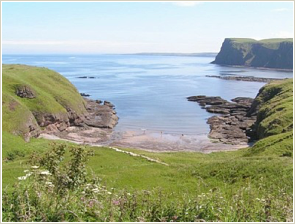
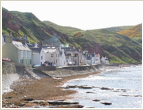
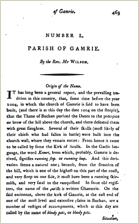
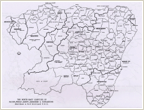
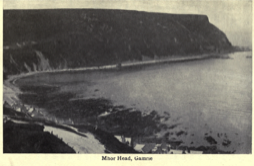
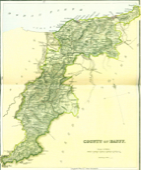
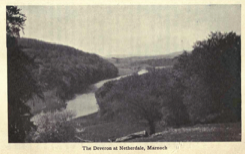

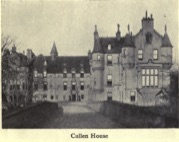
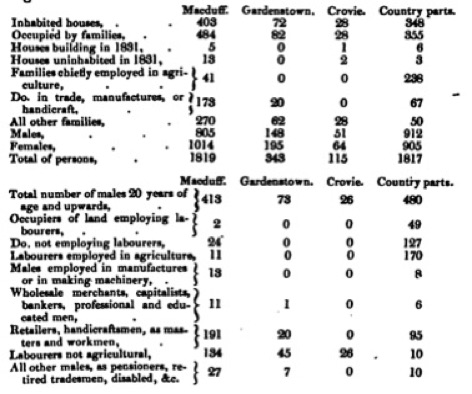

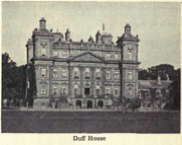
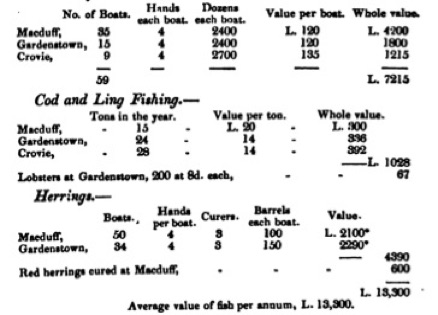
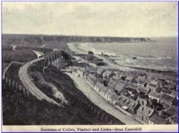
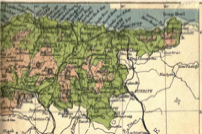
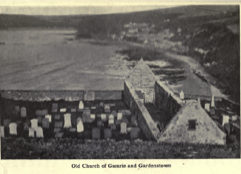
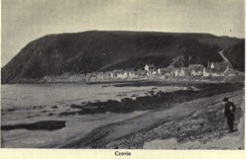
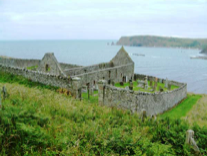
Three or four families, in the south-west of the parish, attend the church of King-Edward, which is much nearer them; and a few on the borders of King-Edward parish, farther east, attend the church of Gamrie for the same reason. The sacrament of the Lord's Supper is dispensed once a-year at both churches, with generally upwards of 700 communicants each. The young are admitted to communion for the first time, after careful instructions and examinations by the ministers for months previous, and strict inquiry into their moral and religious character. The Crown is the sole patron of the parish, and the Earl of Fife's Trustees appoint the minister of Macduff, and pay him a salary of L.80, which they have raised to L.100 for some years past; but, as they will give no bond for his stipend, he has not been admitted to the rank of a quoad sacra minister, although ordained to the pastoral office. The Rev. Thomas Wilson is the third of his family, in a direct line, who has held the office of parish minister of Gamrie. His grandfather was ordained to that charge in 1732.
Education.—There are two parochial schools in the parish; one at Gamrie, and the other at Macduff; each has the salary settled by law in such cases, of L.25, 13s. 3 and one quarter pence with a share of the Dick Bequest. The amount of fees average at Macduff about L.50, and at Gamrie, L.25. The schoolmaster of Gamrie's other emoluments, as session-clerk, amount to L.12, making his living altogether about L.90, with a house and small garden, the rent of which is paid gratuitously by Mr Garden of Troup, as that of the schoolmaster of Macduff is by the Earl of Fife's Trustees.
One private school is now taught at Troup; another at Gardenstown. A handsome new school is erecting at the Longman village by the Earl of Fife, and subscribers in the neighbourhood. There are three private or subscription male schools in the parish, besides several other chance schools, both male and female, in Macduff. The number of children at the parochial school of Macduff, at one time, may average about 110; those at Gamrie about 50. The whole children at school in Macduff, 300; in the other parts of the parish, above 200. There is a female school in Macduff, with a house and moderate endowment, for the useful and common branches of female education, such as reading, sewing, knitting, &c.; and one at Gardenstown, not endowed. It would be a great benefit to this part of the country, if the parochial system were extended, and made to embrace female as well as male education.
Sabbath-school teaching has been in full operation in this parish for some considerable time past. There are about 200 attending the Sabbath school of Macduff, under the superintendence of the minister and schoolmaster, with six or eight subordinate teachers, male and female; and nearly an equal number attend the different Sabbath-schools in the Gamrie district, under the superintendance of the parish minister; but these are in general more thinly attended in summer than in winter.
Libraries.—There is a good circulating library in Macduff, established and supported chiefly by subscription, and the aid of liberal donations from the Earl of Fife. There is no public library in the Gamrie district, although attempts have been made to have one established. The parochial schoolmaster procured the Kildare Street Library for the use of his scholars, which he finds a great benefit in giving them a taste for useful reading. The minister has also procured one of the Tract Society's Libraries for the Sabbath scholars, which is also very well employed and useful.
Savings Bank.—A parish savings bank, on the national system, was established at Gamrie in 1836, is succeeding remarkably well, and gives promise of becoming of vast benefit to the labouring community. The amount of deposits in August 1840 was above L.1300.
Poor and Parochial Funds.—The poor's funds of this parish are nearly exhausted. L.200 was left by the minister's uncle, Hugh Wilson, Esq. of Jamaica; and L.20 by a Mr West, for annuities to be paid to certain poor individuals specified; but the sum is not available for the general poor. The average number of paupers on the roll is 100, besides about twenty families that receive occasional aid. The distributions for the relief of single families are, largest, L.7, 16s.; smallest, 6s.; average, L.2, 3s. 6d. Average amount of contributions for the poor, from church collections, L.100; from voluntary assessment of the heritors, L.100; from alms, legacies, &c., L.50. The heritors assessed themselves last year to the amount of L.100 to supply present wants; but it is to be feared a public assessment cannot long be avoided.
Inns.—Low public-houses have been a great nuisance in this parish and neighbourhood, for a considerable number of years. There are far too many of them yet in the town of Macduff and the villages.
Fuel.—There was peat fuel in the parish, but it is all exhausted. There is, however, an inexhaustible stock of peatmoss, in the hills of Kinbean and Overbrae, in the parishes of Aberdour and King Edward, and from this the farmers drive a considerable portion of their fuel during summer, at a time when there is little else to do for their servants and horses. Were it not for this, peats would be much more expensive fuel in this parish than coals, which are imported in sufficient abundance during summer to Macduff, Gardenstown, and occasionally to Cullycan, generally from the Newcastle and Sunderland mines.
MISCELLANEOUS OBSERVATIONS.
A remarkably good feeling has existed, time out of mind, in this parish, between landlord and tenant. The Earls of Fife and the Gardens of Troup have been proverbial for ages as good landlords. One consequence of this is, that the land is not rack-rented, and the cultivators of the soil are in general what is called well to live; while the landlord, on the other hand, has seldom to complain of ill paid rents. It is a rule with both landlords never to move a well doing tenant. And many is the instance in which the farmer can say or sing,
"The farm I now hold on your honour's estate
Is the same which my grandfather tilled” &c.
Another peculiarity among the tenantry, which proceeds, no doubt, from the same cause, is an endless chain of connection, running through them by kindred and intermarriages. With few exceptions, the families of the whole farms on the estate of Troup are all related in some way to each other. This system of clanship is carried still farther among the fishing population in the villages; the most of whom in Crovie and Gardenstown are of the name of Watt or Wiseman, so that they are obliged to have recourse to nicknames for the sake of distinction. It is a rare thing for them to marry but among themselves, as the manners and habits, as well as the work of the rural population, are quite different from theirs. The influx of strangers, however, at the time of the herring-fishing leads both sexes to form connection with strangers, which will likely in time give more variety of names.
March 1842.
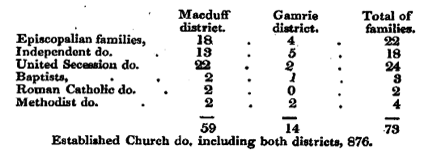
V.—PAROCHIAL ECONOMY.
Market-Towns.—There is a weekly provision market at Macduff on Tuesday, and at Banff, in the immediate neighbourhood, on Friday. Macduff was constituted a royal burgh by charter by George III. in 1783, through the influence of James Earl of Fife, who patronized and greatly improved it. In the early part of the last century, it was only a small fishing village, containing only a few houses, and was called Down; while the land was let in farms. Earl James changed it to Macduff, after his own family name, which is Duff. It is included by the Reform Act within the boundaries of the burgh of Banff, but retains its separate magistrates, namely, a provost, two bailies, and four councillors, elected by the feuars.
Villages.—The village of Gardenstown appears from a record in the baptismal register to have been built in the year 1720, and has remained nearly stationary, as to size and population, ever since.
The fishing village of Crovie is above a mile eastward of Gardenstown. The date of its commencement is unknown, but supposed to be about the same as that of Gardenstown, and Down or Macduff.
A small village called the Longman was commenced on the top of a hill of the same name, about twenty years ago, by the Earl of Fife, on the Banff and Peterhead turnpike; and as the surrounding waste land was let out in small portions to the feuars, the whole in that neighbourhood has been reclaimed, and is now in a state of cultivation. The locality has, therefore, more the character and appearance of a colony of small crofters regularly set down, than of a village.
Means of Communication.—A stage-coach, which used to carry the mail, passes from Banff to Peterhead daily, through the south district of the parish, for upwards of seven miles. A foot post goes on alternate days on the old coast road, the whole length of the parish from Banff to Fraserburgh, through Aberdour and Pitsligo, going one day and returning the other. A carrier also goes regularly twice a week from Gardenstown to Banff, and another carrier goes weekly between Aberdeen and Gardenstown.
The Fraserburgh postman has no house for the delivery of his letters in the parish, except at Macduff. An application is about to be made for a post-office at Dubford, which the postman passes, and where cross roads branch off in all directions; and as there is a considerable amount of correspondence connected with the trade, fishing, and shipping in Gardenstown, as well as from the interior, it is hoped the application will be successful, as the want of a post-office is the greatest privation in the way of communication that the parish has to endure.
Ecclesiastical State.—It would be impossible for one church to accommodate the whole of this parish, on account of its length and population. To remedy this, a very neat and commodious church was built at Macduff, by the late James Earl of Fife, and allowed a small salary for the minister. It has been used as a Chapel of Ease for many years, with the half of the parish attached to it, as to population, and about one-third in regard to extent.
The parish church now stands about the centre of the eastern or Gamrie district, and is as convenient for the parishioners as the very uneven nature of the land and roads admits of. It was built in the year 1830, is a very neat and comfortable place of worship, and abundantly commodious for the congregation, being seated for 1000 sitters, and capable of holding considerably more. An excellent manse was built in the vicinity of the church for the minister, with a suitable steading of offices. The extent of the glebe is about 13 acres, of which about 10 or 11 are arable. The value is about L. 13. The amount of stipend is 16½ chalders of victual, Linlithgow measure, half barley and half oatmeal, calculated annually at the fiar prices for the county. There is also L.8, 6s. 8d. allowed for communion elements.
The great bulk of the population in this parish are members of the Established Church; and their attendance both at the parish church and at the chapel of Macduff is in general regular and punctual, when the weather and roads permit.
The following is the account taken by the two ministers for a census in 1837:


* The price of uncured fish paid to the fishermen.
Navigation.—There is a very commodious harbour at Macduff, built chiefly at the expense of the Earl of Fife, the proprietor. An outer harbour was attempted to be built about twenty years ago, at the expense of the same munificent nobleman; but it was almost wholly destroyed by successive storms. The remaining part of it has been secured, and is of considerable use as a breakwater. There is also a commodious little harbour at Gardenstown, built many years ago by the proprietor of Troup. The shipping at the two ports is as follows in the first table below:—
The exports from both ports generally are, live-cattle for the London market from Macduff, grain, fish; and the imports, lime, coals, salt, wood, and market-goods of all kinds.
Imports and Exports of Macduff for the year from Whitsunday 1836 to do. 1837, which may be considered an average of general years are shown in the second table below:—
The real rental of Troup is upwards of L.3000, and the whole rental of the parish is between
L. 6000 and L.7000.
The rent per acre varies according to the locality, and the quality of the soil. Good land in the neighbourhood of Macduff rents from L.3 to L.1; the best farm land in the country part, from L.2, 10s., and descends, according to the quality, to about 15s. The average rent of a farm may be from L.2 to L.1, 15s. according to the quality.
Recent Agricultural Improvements.—Ploughing and farm-work are, in general, carried to a high degree of improvement in this parish and neighbourhood.
The agricultural improvements which have tended much of late years to increase the value of the produce of the soil have been effected by these means: 1. English lime applied to the land as a manure; 2. bone manure; 3. draining; 4. the ready conveyance of grain and cattle to the London market by sea; and 5. the superior mode of culture, and increased attention to the selection of grains suited to the soil, and to the breeding and rearing of cattle.
I have been favoured with the following account from Mr Gardiner of Greenskains, of the improvements on his farm, which are a good specimen of the improvements in the parish generally. "The first of the more recent agricultural improvements I would take notice of, is bone manure, which was used by me first m the year 1829, and I have continued to use it in large quantities, every successive year, since that time; raising fine crops of turnips, and the other crops in the rotation equally good; the grass after the bone manure is particularly rich, and I have often observe ed that the cattle eat it in preference to grass, after any other manure. The advantages to be derived from this manure in this part of the country are incalculable.
"The additional turnips raised by it keep a greater number of cattle during the winter, and they of course increase the quantity, and improve the quality of the farm-yard's dung, which being laid upon the farm the following year with a little more bone dust, must go on increasing the fertility of the farm to a very considerable extent; and the facility we have here of shipping the cattle to London, and other great markets generally, causes a good demand for the extra number of cattle kept.
"The next improvement I would take notice of is the wedge-draining, or, as it is termed, the frequent draining system of Mr Smith of Deanston. I commenced this operation in 1834, and, since that time, I have put in about 10,000 ells of these drains, and have found the advantage of them very great, both from the increased quantity of corn raised, and also the superior quality of the grass. This, if properly followed out according to Mr Smith's plan, I consider the greatest of our modern improvements; but the expense is so great, that few tenants on a nineteen year's lease would be justified in going on with it to any great extent, without the proprietor bearing part of the expense. But I am perfectly satisfied, that there is a very great deal of the arable land in this parish that could be more than doubled in value by this improvement.
"I would next notice the introduction of the short-horned breed of cattle. I have had that breed on my farm since 1835, and find them thrive uncommonly well, both the pure breed and the first cross from the Aberdeenshire. I can bring them, and have done so, to a greater weight at three years' old, than I used to have the native breed at four year's old; their quality for feeding is decidedly superior; but I do not consider they would be a proper stock for the parish, but on the best farms. I have no hesitation in saying, that for the same quantity of good keep, this will return more money than any other cattle that can be put upon it. But they will never do to be sent to pasture on a heather hill.
"I have kept a flock of about 200 Cheviot sheep for twelve years, bred from the best stocks in Ross-shire and Sutherland. They were at first principally kept on natural grass pasture on the sea braes and burnside, and thrive remarkably well. Within the last few years, I have crossed them with pure Leicester tups, which has increased their size, their propensity to fatten, and also the quantity of their wool. Since using the Leicester tups, I have, in addition to their former natural pasture, been in the habit of depasturing most of my thin arable land by them, which I consider a great advantage on the poor land, first, because a sheep will fatten where an ox. would starve, and second, the manner their dung is scattered over the land must add more to its fertility, than if the grass were eaten by cattle. I also allow them in spring a proportion of the turnips on the worst land, to be consumed on the ground. For the reasons I have stated above, it is my humble opinion that the poorest of the arable land in this parish would be more profitable, if stocked with sheep, than with cattle."
Duration of Leases, Crops, &c—The general length of farm leases in this parish is for the period of nineteen years. A few old different leases still remain on the estate of Troup; but none are given in that way now. The feus in Macduff and Gardenston are perpetual.
The chief crops raised in the parish are oats. Barley is raised to a considerable extent, and Scotch bear on some of the farms; wheat, pease and beans, but rarely. Hay, potatoes, and turnips, are raised in regular rotation with oats. Large quantities of grain are shipped annually for the London and other markets, while barley and bear are generally sold to the home brewers and distillers.
There are two rotations of cropping throughout the parish, according as the nature of the different farms is found suitable,—the seven years and the five years. The former consists of two crops of oats, one of turnip or potatoes, one of barley or oats, and three of grass. The five years' rotation has one crop of oats, one of turnips or potatoes, one of barley or oats, and two of grass. Land is scarcely ever fallowed here, except before a crop of wheat.
Manufactures.—There are five meal-mills in the parish, three saw-mills, one for grinding bones for manure, and another building. At Mr Carny's manufactory of rope and sails at Macduff, 50 tons hemp for sails, value L.1500; nets, L.900; total, L.2400. Capital of the Gas Light Company,
L.1800, pays 5 per cent. Capital of the bone and saw-mill company, L.10,000.
Of the three fishing stations in the parish, the following account is taken in answer to minute inquiries at the principal curers. The cod, ling, and small fish are principally sold in the towns on the south and west friths, the herrings at Stettin, Hamburgh, Russia, Ireland, the West Indies, &c.
Average number of haddocks, whitings, and other small fish taken in a year:
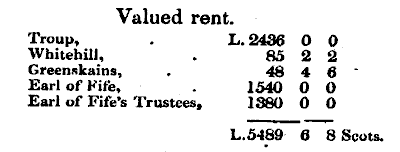

IV.—INDUSTRY.
Agriculture and Rural Economy.—Waste land has been improved of late years to a very considerable extent, and its improvement, in most cases, has yielded ample remuneration for expense and labour. These improvements, together with the superior mode of cultivating land now in use, have altogether more than doubled the produce of the soil in this parish since 1790. There remains yet a large proportion of waste ground that might be brought under cultivation with advantage.
The extent of the Troup estate, according to a late survey, when reduced from Scots to imperial acres, is as follows [first table below]:—
Altogether Troup, Whitehill, and Greenskains, are generally considered as amounting to half the parish, both as to extent and value of land; and the following [second table] may be taken as a fair average calculation of the whole in imperial acres:—
Of the 10,000 acres waste land, about 3000 or 4000 may be capable of tillage, and would yield a fair remuneration for capital laid out on it. The remainder, from the mountainous nature of the ground, want of water on the heights, and other causes, may be considered irreclaimable.
Rent of Land [third table below].—

Most of the country inhabitants are employed in agriculture, as farmers, crofters, labourers or farm-servants.
There are five landed proprietors, and thirty tenants paying L.50 and upwards of yearly rent. The others, as in the following table:
The number of illegitimate births in the parish, 12 annually, at an average. There are in the parish 2 insane persons, 4 fatuous, 4 blind.
The heaths, fruits, and forest-trees, are those which are common in the north of Scotland.
Woods, Plantations, &c.—There are some very pretty and luxuriant belts of wood in the western extremity of the parish, particularly that on the river side, connected with the extensive plantations of Duff House, in the adjoining parishes of Alvah, Banff, and King Edward.
The Earl of Fife has done much to beautify and improve that part of the country; and, among the late improvements, has extended a fence with hedges on either side of the turnpike, with occasional clumps of trees, as also neat cottages and lodges, with tasteful gardens, all the way from Banff and Macduff to the Church of King-Edward, a distance of five miles. The chief plantation in the parish, however, is the Tore of Troup, which, together with the woods of Troup House, measures upwards of 700 imperial acres. The principal wood is beech and Scots fir; the former, much admired for the largeness of the trees and wide-spreading foliage. Larch-fir is now coming more into general use, as it is of more rapid growth, and is considered more durable and suitable for husbandry use than the other kinds of fir in this part of the country. The deepness of the numerous ravines, and the towering height and steepness of the banks, diverging from the bottom or principal glen in all shapes, and at all angles, give the Tore a striking resemblance to a Highland mountain-pass, and render the scenery altogether exceedingly romantic and beautiful; while the proprietors, who have been proverbial for ages for good taste, have made art assist nature in rendering this one of the loveliest spots in the far north.
II.—CIVIL HISTORY.
Parochial Registers.—The parochial registers extend no farther back than 1704. Since that time minutes of the kirk-session's transactions, and of the collections and distributions for the poor, have been regularly kept. Registers of baptisms are also preserved since that time; but in these there are very frequent omissions, owing to the neglect of parents; and parties are very frequently subjected to inconvenience and loss afterwards in consequence of these omissions. A register of marriages has also been kept and preserved since 1757; but no regular account is kept of deaths in the parish.
Antiquities and Historical Events.—These may be taken together, as there is no modern historical event worth mentioning connected with this parish. The greatest object of antiquity is the Old Church, which universally-received tradition relates as having been built at the time of the landing of the Danes in 1004. The following account of the place and its tradition was furnished by the writer to the Aberdeen Magazine, 1832, and is believed by the inhabitants to be substantially correct.
"It is not alone by the natural beauties of the place that this scenery becomes a field peculiarly adapted for the fancy to sport in. These green hillocks, grotesque knolls, rugged rocks, and deep gulleys—these vales which have rested for centuries in peace, were once the scene of deadly conflict; for it was here that our far-off ancestors had to stem the torrent of invading Danes; and this brook, now meandering peacefully over the smooth pebbles, once flowed red with the blood of the slain. That green conical mound that tops the east bank of the den, is the castle hill of Findon. It was garrisoned with a part of the Scotch army stationed here to watch the landing of the Danes; a party of whom effected a lodgement on the opposite bank, in the place where the Old Church now stands. The alarm was immediately given, and communicated by means of fires on the mounds, (several of which mounds yet remain on the highest eminences of this and the neighbouring parishes), which communicated the intelligence rapidly through the kingdom, and quickly brought up reinforcements. Still the Scottish chief (the Thane of Buchan) considered the issue of an attack rather dubious, and, in order to add the enthusiasm of religion to that of patriotism among his followers, made a solemn vow to St John, in presence of the whole army, to build a church to him on the spot where the invaders were encamped, on condition that the saint would tend his assistance in dislodging them. The superstitious soldiers, thinking this too good an offer for any saint to reject, made themselves sure of St John's co-operation, and entered with alacrity into the plans of their leader; who, being now sufficiently reinforced, sent a detachment round by the head of the den, and these, fetching a compass by the south-west, succeeded in gaining possession of the top of the hill, directly over the Danish main camp, and, by rolling down large stones upon the invaders, obliged them to abandon it, and to make their escape by the north-east brow of the hill which overhangs the sea, where many were killed in the flight; whence the place obtained the name of Ghaemrie, or the running battle. After being dislodged from the east, the Danes formed a new camp, (where the entrenchments are still to be seen), which still preserved their communication with the sea, and also with an extensive barren plain on the top of the hill. Meantime the whole Scottish army, in fulfilment of their leader's vow, set to work and built the church on the spot where the Danes first settled, while both parties were waiting additional reinforcements. The Danes having been joined by a party of their countrymen who had landed at Old haven of Cullen, about four miles westward, made a successful attack on the Scots, and drove them back to the castle hill; and, in spite to Saint John for assisting their enemies, they polluted his sanctuary by making it a stable for their horses. By this time, however, the alarm had spread far and wide, and the Scots, pouring in from all quarters, not only forced back the Danes to their old position on the brow of the hill, but, getting possession of the whole heights, and enclosing them on all sides except that overhanging the sea, they again commenced their murderous work of rolling down stones, while the helpless Danes could neither oppose nor escape, and then rushing down upon them, sword in hand, the Scots cut them to pieces to a man. The Bleedy pots (Bloody pits) is still the name of the place, which, being incapable of cultivation from its steepness and exposure to the north blasts, remains to this day in statu quo. Besides the round, the crescent, and variously angled figures in the ground, the graves of the Danes are yet to be seen, sunk and hollow, among the rank brown heather, green at the bottom, and surrounded at the borders with harebells and whortleberries, with fragments of rock and large detached stones lying around, and covered with moss.
"Three of the sacrilegious chiefs were discovered amongst the slain, by whose orders the church had been polluted; and I have seen their skulls, grinning horrid and hollow, in the wall where they had been fixed, inside the church, directly east of the pulpit, and where they have remained in their prison-house 800 years!
"After the church became a neglected ruin, about twelve years ago, these relics of antiquity (skulls) were pilfered bit and bit, by some of the numerous visitors to the place, (one was subsequently recovered and placed, for greater security, in the Museum of Lit. Inst. Banff, where it is still to be seen,) and nothing of them now remains but the holes in the wall in which they were imbedded."
There is an old ruin in the farm of Pitgair, called Wallace Castle; with very thick walls, composed of stone and lime half-vitrified, standing on a knoll, in a very romantic spot: but there is no history or tradition known connected with it. The walls have the same appearance as those of the old church, namely, that of great antiquity.
Land-owners.—The land of the parish of Gamrie is nearly equally divided between the Earl of Fife and Francis Garden Campbell, Esq. of Troup and Glenlyon, the former possessing the west end of the parish and the latter the east. The only exceptions are two farms, Whitehall and Greenskains, west of the old church and den of Afforsk, which, being the only unentailed property on the estate of Troup, were sold during Mr Garden's minority some years ago; Whitehill to Dr Smith in Banff, and Greenskains to Mr Al. W. Gardiner, who rents the farm and resides in the mansion-house of Melrose, in the immediate neighbourhood. Part of the Fife estates in the parish are in his Lordship's own possession, and part of them in the hands of trustees, in terms of a deed left by his uncle, the late James Earl of Fife.
Eminent Persons.— Several members of the ancient family of the Gardens of Troup have distinguished themselves in the camp, the Court, and Judges' hall. One of Mr Garden's predecessors, Alexander Garden, Esq. of Troup, was unanimously elected Member of Parliament for the county of Aberdeen, in the middle of the last century, during three successive parliaments. He was succeeded by his brother, Lord Gardenstoun, one of the Lords of Session, who was distinguished in his time as an eminent lawyer, a man of letters, and a gentleman of highly cultivated taste and intellect. Several of the family also have served their country with much approbation, both at home and abroad, as officers in the army. The Barclays de Tolly, one of whom figured in the last war, had their seat in old times at Cullen, in this parish, and their burial-place within the church, where there still remains a Latin inscription, in old characters, recording their name and interment.
Modern Buildings.— The mansion-house of Troup, which was built principally for a sea-view, about seventy years ago, seems at a distance as having rather a bare appearance, from want of wood on the south and east sides; but this appearance gradually wears off in approaching, and when the approach is made, the situation is found to have been well chosen. The ground rises to such a distance in front, towards the south, that wood in that quarter, more or less, would impose a look of confinement and closeness on the whole scenery:—while the opening to the east leaves to the windows in that part of the house, a splendid prospect of the gigantic rocks of Pennon, which, when seen in a mild evening, gilded by the setting sun, and relieved on the one side by the smooth blue ocean; and on the other, by the various shades of green, in the highly cultivated fields, knolls, brakes, and gulleys, presents a scene of natural grandeur seldom equalled.
In the close vicinity of the house, there are two beautiful ravines, meeting at right angles, and nearly half surrounding it, the one on the west and the other on the north. The latter, after passing the house, rises with a gentle acclivity, leaving a fine southern exposure for garden and pleasure-ground. As these glens were tastefully laid out with walks, and planted some thirty or forty years ago, they are now smiling in all the beauty which wood and water, well trained, can give to a place that would be beautiful without either, from its natural position of banks and braes. As these woods and vales are little seen in the approach from the east, the effect to a stranger arriving from that quarter is heightened by agreeable surprise.
The house itself has been allowed to go into considerable disrepair during the long minority of the present landlord, as well as the sweet Norwegian cottages of the Tore; but when the improvements on the house, &c. projected by the young and spirited proprietor, are carried into execution, it will be exceeded as a baronial residence, by few in the north, and hardly by any in natural beauty of site.
III.—POPULATION.
My paternal grandmother’s family originally came from the parish of Gamrie – hence the reason for including it here. It affords another view of the life of our ancestors. The Old or First Account is dated 1791. The New Account is dated 1842.
**********
PARISH OF GAMRIE
By the Rev. Mr Wilson
Origin of the Name.
It has long been a general report, and the prevailing tradition in this country, that, some time before the year 1004, in which the church of Gamrie is said to have been built, (and there is at this day the date 1004 on the steeple), that the Thane of Buchan pursued the Danes to the precipice or brow of the hill above the church, and there defeated them with great slaughter. Several of their skulls (most likely of their chiefs who had fallen in battle) were built into the church wall, where they remain entire: From hence it came to be called by some the Kirk of Sculls. In the Gaelic language, the word Kemri, from which, probably, Gamrie is derived, signifies running step or running leap. And this derivation seems a natural one; because, from the situation of the hill, which is one of the highest on this part of the coast, and very steep on one side, it must have been a running skirmish, and very fatal to the vanquished. In some old registers, the name of the parish is written Ghaemrie. On the said eminence, above the kirk of Gamrie, at the east end of one of the most level and extensive plains in Buchan, are a number of vestiges of encampments, which at this day are called by the name of bloody pots, or bloody pits.
Situation, Extent, &c—The church and manse of Gamrie are built in a very extraordinary and romantic situation, on a sloping piece of ground in the middle of a hill, and not a mile from the town and harbour of Gardenstown. By two headlands, called Gamrie and Troup head, which project a considerable way into the sea, a beautiful bay is formed, where there is fine anchoring ground, and vessels can ride in safety. At high water, a person could sling a stone into the sea from the church; and looking out of it, it has the appearance, to a stranger, as if the sea washed its foundations. The church is built, after the manner of some very old edifices, with unslacked lime, and with very thick walls; and, although it has already stood upwards of 700 years, it may, if the roof be kept in proper repair, last for hundreds of years to come. The north side of Gamrie parish is bounded by that part of the German Ocean called the Moray Firth; on the east by the parish of Aberdour; on the south by the parishes of Monwhiter and King Edward; and on the west by the river Dovern, which separates the parish of Gamrie from Banff. This parish stretches 9½ miles along the sea-coast, which is a very bold one. It is almost a continued chain of stupendous rocks, in many places perpendicular, and 200 yards above the sea. It is between 3 and 4 miles broad. Gamrie parish lies in the county of Banff, presbytery of Turriff, and synod of Aberdeen. The soil, in many places, is very fertile, and in others as barren; and, though much has been done of late years, there is still great scope for improvement. The hilly ground is in general covered with heath, and in some places with a coarse kind of grass, on which sheep and young cattle are fed. Sheep, indeed, are very much banished from the parish. When Mr Wilson first came to the parish, there was scarcely a farmer who had not a flock; but now there are only two or three that have any at all. This is in a great measure owing to the introduction of sown grass, and the difficulty there is in winter herding, unless the practice was general.
Sea Coast, and Fisheries—On this coast a variety of different kinds of fish are caught, viz. ling, cod, haddocks, whitings, turbot, skate, &c. with which this country used to be remarkably well supplied, and a considerable quantity of them, when dried, were carried to the Firth of Forth, and sold there. From the best information, it appears that the fishermen in this parish have sometimes received for their salt fish L.250 annually. Of late years, the fishing has been so remarkably poor, (to what cause it is perhaps difficult to say, but most likely one principal reason is, the immense quantities of seadogs, a kind of shark, with which this coast has been infested), that there has hardly been fish sufficient to supply the markets at home. Of consequence, it is to be supposed they have risen much in value. Long after the present minister was settled in the parish, he could have purchased haddocks at one penny and three half-pence a dozen, which now cost a shilling to eighteen pence; and in proportion for other kinds of fish, and every other article of food. On this coast, great quantities of sea weed, called ware, are thrown up on the shore, which the farmers lay on the ground, and find very profitable in raising crops of barley. In this parish, it is laid on with a very sparing hand, owing to the steepness of the coast, and the bad access to the shore. Considerable quantities also of this sea-weed are cut off from the rocks, for the purpose of making kelp. At an average, about 30 tons are made annually, which fell from L.3 to L.5 a ton. On the river Dovern, which separates the parishes of Banff and Gamrie, is an exceeding good salmon fishery, the property of Lord Fife, which lets for L.1000 per annum. The salmon are all cared in the town of Macduff. The pickled fish are all sent to the London market, and what are salted are generally exported to France and Spain.
Mineral Springs, Quarries, &c.—Near the sea-coast, and in the neighbourhood of Macduff, is a pretty good mineral spring, called the Well of Farlair, which has been useful in gravellish complaints. Of late years it has come into considerable repute, and a number of people resort to it annually. In this parish, upon the estate of Melrose, now the property of Lord Fife, is a very good slate-quarry. The quantity annually made has been various, depending on the demand, and the number of hands employed. The slates are of a good quality, of a beautiful blue colour, not inferior to the Easdale slate, only thicker, larger, and make a heavier roof. Quarriers are commonly paid by the piece, which is certainly the best way for themselves and their employers. Common day-labourers usually receive from 7d. to 9d. a day in winter, and from 9d. to 1s. in summer.
Natural Curiosities.—Near the east end of the parish, and not far from the house of Troup, are three great natural curiosities. 1. A perpendicular rock of very great extent, full of shelves, and possessed by thousands of birds called Kittyweaks. These arrive in the beginning of spring, and leave it again towards the end of August, after they have brought forth their young. So the people are fond of eating the young Kitty's; but the shooting of them is a favourite diversion every year. The season for this is commonly the last week of July. Whither these birds go in winter is not known; most probably it is to some place upon the coast of Norway. 2dly, A cave, or rather den, about 50 feet deep, 60 long, and 40 broad, from which there is a subterraneous passage to the sea, about 80 yards long, through which the waves are driven with great violence in a northerly storm, and occasion a smoke to ascend from the den. Hence it has got the name of Hell's Lumb, i.e. Hell's Chimney. 3. Another subterraneous passage, through a peninsula of about 150 yards long from sea to sea, through which a man can with difficulty creep. At the north end of this narrow passage is a cave about 20 feet high, 30 broad, and 150 long, containing not less than 99,000 cubic feet. The whole is supported by immense columns of rock, is exceedingly grand, and has a wonderfully fine effect, after a person has crept through the narrow passage. This place has got the name of the Needle's Eye. There are in the parish several tumuli. Not many years ago, one of them, in the neighbourhood of Macduff, was opened; and there was found in it an urn, containing a considerable number of small human bones.
Population.—The population of the parish is nearly double since the year 1732. At the above period the parish contained 1600 souls, and now nearly 3000. About the years 1704 and 1705, it appears by the Registers that the number of births annually, at an average, were then 45; and, for several years past, they have not been under 60. The number of deaths cannot be ascertained so far back. About 30 years ago they were from 10 to 12, and for 7 years past nearly 20 annually. About 30 years ago there were from 12 to 14 marriages annually, and, for 7 years past, not less than 26.
In this parish, many instances of longevity might be mentioned. It is only a few years since a fisherman in Macduff died at the age of 109; and there are living at present several persons 90 years old and upwards. Mr Wilson is in his 97th year; and last autumn, at the conclusion of the harvest, the age of him, and the two servants that assisted in taking in his crop, amounted in all to 257; and it is worthy remarking that one of these has been his servant 50 years. Mr Wilson was the first that introduced turnips and potatoes into the parish. He had a few of them in his garden, which the people in coming to the church used to look at as a great curiosity; and it was thought, at that time, that none but a gardener could raise them. It was long before the method of hoeing came to be thought of. Being sown thick, and hand-weeded, they came to no size. Another singularity deserves notice, viz. that, when he came to Gamrie, there was not a watch in church except the laird's and the minister's.
Church.—The minister's living is, communibus annis, L.100 Sterling; the crown patron. The present incumbent was settled in the year 1732. He has been a widower for ten years past; has had 14 children; ten of whom (five sons and five daughters) he has lived to see well settled in the world.
Poor.—In such a popular parish, it is to be supposed there will be several poor, and accordingly between 50 and 60 receive charity out of the parish funds; and of these the year 1782 added several to the list. The weekly collection at Gamrie and Macduff is at an average 14s. L.450, which is at interest, belongs to the poor of this parish.
Rental.—The valued rent of the parish is L.5489 : 6 : 8 Scots. The present real rent, exclusive of fisheries, is nearly L.1680 Sterling.
Towns, Villages, and Miscellaneous Observations.—The principal causes of the increase of population are, the number of fishing towns on the coast, the breaking of large farms into smaller ones, the encouragement given by the heritors to improve waste ground, and their endeavouring to introduce a better mode of culture. The principal town in the parish is Macduff, the property of Lord Fife. In 1732 there were only a few fishermen's houses in Macduff, but now there are several well laid out streets, and 1000 souls in the town. The harbour, on which his Lordship has already laid out upwards of L.5000, will, when finished, be one of the best in, the Moray Firth. There are ten vessels from 60 to 120 tons burden, and 6 fishing boats, belonging to Macduff. Three of them are in the London trade, two in the east country trade, and the others trade most commonly to the Firth of Forth.
Since the great increase of population in this part of the parish, his Lordship has erected a Chapel of Ease in Macduff, for the accommodation of the inhabitants, who are nearly six miles from their parish church, and gives a salary to a qualified clergyman to preach and dispense the ordinances of religion among them.
On the east end of this parish, there are very near to one another two other small towns, Gardenston and Crovie, both the property of Lord Gardenston, and not far from his house at Troup, The town of Gardenston contains nearly 300 souls, and Crovie 100. In these two places are the same number of vessels and fishing-boats as in Macduff, only the vessels are of a smaller size. Lords Fife and Gardenston are the only heritors. Lord Fife does not reside in the parish, but one of his principal seats (Duff-house) is very near it, being only about an English mile from Macduff. His Lordship has paid the greatest attention to the improvement of his estates, and the good of the country, by encouraging, inclosing, binding his tenants to have yearly a certain quantity of their ground in turnip, so much in fallow, and so much laid down in grass feeds. These regulations were highly proper and necessary some years ago, because people are led in chains by habit; and it is by slow degrees, and well digested plans, they are made to depart from established customs: But, now that the propriety of these regulations are seen, it would be difficult to make the farmers have such small quantities of turnip, &c. as it was necessary at first to restrict them to. Lord Fife has also converted the whole customs and services (usually called bonnage) at a moderate rate. This is of the utmost importance to the tenants. Not many years ago, many of them paid nearly one-half of their rent in fowls, eggs, sheep, &c. delivered in kind, and the labour of themselves, their servants, horses, in seedtime and harvest, carriage of peats, and many other works in the different seasons throughout the year, when called for; by which means they were often obliged to plough, dung, and harrow their landlord's ground, and lose the season for their own. Planting is a mode of improvement in which no person in this country has been more successful than the Earl of Fife. His Lordship has planted not less than from 7000 to 8000 acres on his different estates, which he continues yearly to increase; and at this moment the whole is in a very thriving state. An account of the various kinds of trees, and the method taken to rear them, will be seen in Young's Annals of Agriculture, and the Minutes of the Society of Arts and Commerce. The most considerable plantation in this parish is what is called the Tore of Troup. There are upwards of 600 acres planted with trees of various kinds, in a thriving state. These were reared chiefly by the direction of the late Mr Garden of Troup, and begun by his grandfather. Mr Garden, who is now succeeded by his brother Lord Gardenston, was unanimously elected member of parliament for the county of Aberdeen, during three succeeding sessions of parliament; he constantly resided at Troup, in this parish, excepting the time he attended parliamentary business, and paid great attention to the improvement of his estate, and the good of his country. He never gave a shorter lease than for a life; and to several of his tenants he gave very long leases, viz. a life, two nineteen years, and a life. He was not like many others, who, when they saw a tenant thriving, thought he had too good a bargain, and would demand a very high rent at the next letting. It was his joy to see his tenants carrying on their improvements, and prospering by their honest industry. Nor, when any of his leases fell vacant, was it ever known that he did not prefer the tenant's own son, and continue him in the possession, if he was disposed to follow the same occupation with his father. And it may be safely said, that, owing to the encouragement given by Lord Fife and Mr Garden, there are few tenants in the north of Scotland more thriving than in the parish of Gamrie. In the year 1782, when many others were not able to pay their rents, scarcity was not much felt except by the poorest class.
The language spoken in this parish is the Scottish, with an accent peculiar to the north country. There is no Erse.
The fuel used in the parish is partly coals and partly peats. The latter has of late years become very scarce; and coals are every day much more commonly used; which, owing to a partial and oppressive tax, cost very dear, and is a very great hindrance to improvement in this part of the country. It is certainly very unfair, and highly absurd, that this necessary article, which at any rate must be considerably higher in price to consumers in the North, from the expence of carriage, than it is to those on the other side of the Redhead, should also be loaded with a tax from which the southern inhabitants are exempted: And it is to be hoped the wisdom and justice of the legislature will soon provide a remedy, either by a total repeal, or by making the tax payable at the pit, which would thereby become general, and be much less partially felt.
